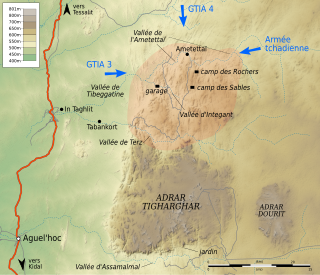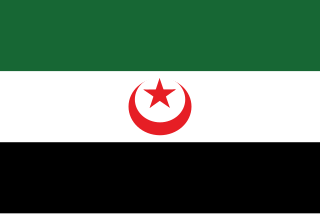
Azawad, or Azawagh was a short-lived unrecognised state lasting from 2012 to 2013. Azawagh (Azawaɣ) is the generic Tuareg Berber name of all Tuareg Berber areas, especially the northern half of Mali and northern and western Niger. Its independence was declared unilaterally by the National Movement for the Liberation of Azawad (MNLA) in 2012, after a Tuareg rebellion drove the Malian Army from the region.
The May 23, 2006 Democratic Alliance for Change is a Malian Tuareg rebel group, formed in 2006 by ex-combatants from the 1990s Tuareg insurgency in Mali. In 2007, splinters of the organisation returned to combat in northern Mali, launching the Malian element of the 2007 Tuareg insurgency. Led by Ibrahim Ag Bahanga, this ADC faction continued to operate under that name, despite most elements remaining under ceasefire. In July 2008, most of these elements, along with much of the splinter following Ag Bahanga reached another accord with the Malian government in Algiers. Ag Bahanga and a faction of that group rejected the accord and fled to Libya. At the end of 2008, this faction returned to fighting, operating under the name Alliance Touaregue Nord Mali Pour Le Changement (ATNMC). The government of Mali has contended since 2007 that the Ag Bahanga faction of the ADC is a "band of marginals" who were "isolated from the heart of the Tuareg community", primarily motivated by lucrative Trans-Saharan smuggling operations operating from Ag Bahanga's home town of Tin-Zaouatene. Ag Bahanga and the other leaders of his faction contend that the government of Mali oppresses the Tuareg population of the north, and has repeatedly failed to live up to its agreements with the ADC and other groups. Outside observers have also speculated that internal rivalries between Tuareg from the Kel Adagh and the Ouilliminden confederations have frustrated peace attempts.
The Dawsahak people, Idaksahak are pastoralist Berbers centered on Ménaka and Inékar town in Menaka Cercle and Talataye in Ansongo Cercle of the Gao Region of northeastern Mali. They speak the Northern Songhai language Tadaksahak. Many also speak Western Tawallammat Tamajaq language, the Tuareg language of southern Gao. Daoussahak appears to be the most common transliteration of the collective name among French and English academics.

The Tuareg Rebellion of 2012 was an early stage of the Mali War; from January to April 2012, a war was waged against the Malian government by rebels with the goal of attaining independence for the northern region of Mali, known as Azawad. It was led by the National Movement for the Liberation of Azawad (MNLA) and was part of a series of insurgencies by traditionally nomadic Tuaregs which date back at least to 1916. The MNLA was formed by former insurgents and a significant number of heavily armed Tuaregs who fought in the Libyan Civil War.

The National Movement for the Liberation of Azawad or the Azawad National Liberation Movement, formerly the National Movement of Azawad, is a political and military organisation based in Azawad in northern Mali.
The Movement for Oneness and Jihad in West Africa or the Movement for Unity and Jihad in West Africa, was a militant Islamist organisation that broke off from Al-Qaeda in the Islamic Maghreb with the intended goal of spreading jihad across a larger section of West Africa, as well as demanding the expulsion of all French interests that operates in West Africa, which they regard as "colonialist occupiers".

The Battle of Gao was fought between the National Movement for the Liberation of Azawad (MNLA) and the Islamist Movement for Oneness and Jihad in West Africa (MOJWA), along with its ally Ansar Dine, in Gao between 26–28 June 2012. By the 28 June, Gao, Timbuktu and Kidal, the three biggest cities in the disputed secessionist region of Azawad within what is recognised as Malian territory, were under the control of Ansar Dine and its Islamist allies.

The Mali War is an ongoing armed conflict that started in January 2012 between the northern and southern parts of Mali in Africa. On 16 January 2012, several insurgent groups began fighting a campaign against the Malian government for independence or greater autonomy for northern Mali, which they called Azawad. The National Movement for the Liberation of Azawad (MNLA), an organization fighting to make this area of Mali an independent homeland for the Tuareg people, had taken control of the region by April 2012.

The Second Battle of Ménaka was the last battle fought by the state of Azawad, as they were defeated by an Islamist coalition.

The Battle of Ifoghas, also known as the Battle of Tigharghâr or the Battle of the Ametettai, took place from 18 February to 31 March 2013, during the Northern Mali conflict. The French army and the Chadian army fought armed Salafist jihadist groups led by Al Qaeda in the Islamic Maghreb and Ansar Dine. After being defeated in January in the Battle of Konna and the Battle of Diabaly, the jihadists abandoned Timbuktu and retreated into the Adrar Tigharghar, a mountain of the Adrar of Ifoghas in northeastern Mali, which has been their sanctuary for years. The French started quickly a pursuit, and they took control of the towns of Tessalit and Aguelhok and begun the operation Panther in the Tigharghar. The first clashes erupt on February 18 and are mainly concentrated in the Ametettai Valley. It is caught between two armored columns, one French to the west and another Chadian to the east, while the paratroopers manage to surprise the jihadists by attacking on foot from the north. The valley is taken on March 3 and jihadists begin to gradually abandon the Tigharghar. Excavation missions and some skirmishes, however, continue to take place the following days. The operations cease on March 31. The battle was a turning point in the war, as with the capture of the Tigharghar, the jihadists lose their main sanctuary in the Sahel as well as most of their military arsenal, taken from the Malian army or Libya.

The following is a timeline of major events during the Northern Mali conflict.
The Battle of Khalil took place on 22–23 February 2013 and was part of the Northern Mali conflict, the battle began on the 22nd with two suicide bombings.

On March 23 2013, a battle took place in Gao between MUJAO and Malian army. The Malian army repelled the attack.

The Arab Movement of Azawad is an Arab military organization active in Azawad/northern Mali. Initially known as the National Liberation Front of Azawad, it was formed in early 2012, during the 2012 Tuareg rebellion. The MAA claims to be a secular, non-terrorist organization, whose main objective is to defend the interests of the Arab peoples of northern Mali. It is reportedly willing to "work with France against terrorism, drug trafficking and organized crime" in the region. The group calls for granting substantial autonomy to northern Mali.
The first battle of Menaka is an attack led on January 17, 2012, by armed groups of the National Movement for the Liberation of Azawad (MNLA) and marks the beginning of the Tuareg rebellion of 2012. This is the first in a series of battles aimed a capturing most of the north Mali from the army by the rebels.
The Ambush of Tin-Hama took place during the Tuareg rebellion of 2012, on March 25, 2012, when a convoy of the Ganda Izo militia was ambushed by the MNLA.
The battle of In Emsal took place during the Tuareg rebellion of 2012. On 20 January, a Malian military convoy that came to rescue the garrison of Aguelhoc was ambushed by rebels of MLNA, and terrorists of Ansar Dine and AQIM.
The Battle of Idelimane took place during the Internal Conflict in Azawad.
The Battle of Tabarde was fought over three days from 3 to 5 June 2018, between ISIL militants and a Tuareg coalition that consisted of the Imghad Tuareg Self-Defense Group and Allies (GATIA) and the Movement for the Salvation of Azawad (MSA).
Ba Ag Moussa was a Malian militant and jihadist.









